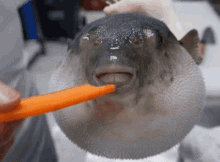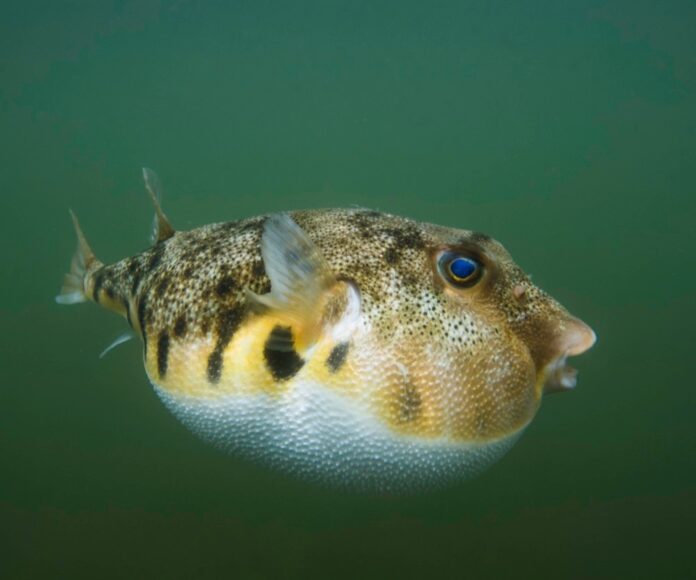The Atlantic Puffer Fish (Sphoeroides maculatus), or also known as the Northern Puffer Fish, is often enveloped in an aura of mystery and intrigue. This species of Puffer fish is located within the temperate waters of the Western Atlantic, ranging from Canada to Florida. In these waters, predators have become deterred to approach these puffer fish on account of their infamous defense technique giving both its iconic likeness and name; puffing up into a spiky, poisonous ball.
Description:
The Northern Puffer Fish has a stout body with a gray, green, or brown back and a white belly, adorned with dark spots and splotches that aid in camouflage. Its skin is tough and lacks scales, and it has small, spiny protrusions that are more pronounced when the fish is inflated. As a part of the Puffer fish family, this fish has a remarkably strong bite despite its unassuming appearance and size. It’s “teeth” have fashioned into a sharp, beak-like appendage which is optimal for crushing shells and bone. The likewise act of crushing has been studied to easily be able to rip through the shells of crabs and clams, and sometimes even the finger of a unfortunate diver or fisherman.
Defenses:
Unique amongst the Puffer Fish species, the Atlantic Puffer fish doesn’t have protruding spines that help both to inflate the animal and help to further deter predators. The Northern pufferfish goes around this issue with its way of inflating rapidly, utilizing rapid intake of air or water into its elastic underbelly. This serves a dual purpose of intimidating predators, along with increasing the difficulty of getting consumed whole, a marine predator’s most preferred method of eating prey. Imagine putting a grape into your mouth to eat, only for it to expand to the size and hardness of a softball! This techniques allows for the Northern Pufferfish to deter nearly any predator which tries to attack it.

Another known defense of the animal is the secretion of the poison tetrodotoxin. Tetrodotoxin blocks sodium channels on nerve cells, preventing the normal transmission of signals between the brain and the body. This blockade can lead to paralysis and, in severe cases, death due to respiratory failure. The presence of this poison in the animal is not as a result of the production from certain glands, rather as a result of its diet. Some bacteria it consumes undergoes digestive properties which produce this extremely deadly toxin via alcoholic fermentation. The toxin serves as a powerful defense mechanism against predators, making pufferfish a dangerous meal choice. This deterrent effect helps to reduce predation on pufferfish, allowing their populations to thrive.
Behavior:
This species tends to be solitary, with individuals often maintaining and defending their territories, especially during the breeding season. They may display aggressive behaviors towards other puffers that invade their space. This aggressive nature only amplifies as the Northern puffer enters into their breeding seasons. During the breeding season, Atlantic Puffers engage in specific reproductive behaviors, including the release of eggs and sperm into the water for external fertilization. The exact details of their mating rituals and courtship behaviors are less documented compared to other aspects of their life history. Regarding their diet, the Atlantic Puffer is an opportunistic feeder, consuming a wide variety of prey, including mollusks, crustaceans, and small fish. It uses its aforementioned beak-like mouth to crush the shells of snails and clams, showcasing a behavior adapted to exploiting the hard-shelled prey found within its habitat.

Stay tuned to The Roundup for more Animal of The Week articles!






